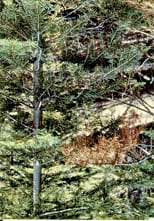Valsa kunzei (Cytospora kunzei) (fungus), V. nivea (C. nivea), V. sordida (C. chrysosperma)
Affected trees include aspen, cherry, elm, fir, maple, mountain ash, poplar, spruce, and willow throughout the Continental United States and Canada.
Wounding, improper pruning, poor ventilation, and moist atmosphere are causes.
Cytospora is irregular diffuse to the cankers on/and girdling trunks and large branches, from which yellow to red-brown spore horns or tendrils develop in moist spring weather; diseased bark discolored with black pimples; sapwood red-brown and water-soaked; wilting and dis-coloration of leaves often accompanies canker formation, followed by dieback of small branches and twigs. Needles of spruce and fir become yellow-green to purple, progressing up crown; copious resin flow from infected branches, coating cankers. Spruce cankers slightly swollen.
Spores contact wounds or branch stubs and germinate in moist atmosphere; living wood is invaded where the fungus becomes established at periphery of dead and live wood. New spores are produced in flask-shaped fruiting structures (pycnidia). Waxy tendrils release spores when wet to re-infect new wounds and branch stubs. Invasion by spores is direct or through needle scars in spruce and fir. Spores are either airborne or spread by insects, clothing, or pruning tools.


